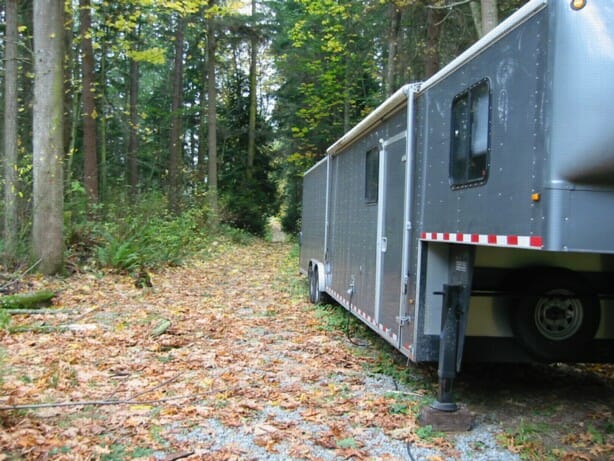
Microship Test in Wisconsin & 7,000 Mothership Miles
I’ve been doing this for so long that it hardly seems strange… until I think about it for a minute.
I mean… it’s Monday night in a campground at the foot of Mount Shasta. I’m reclining on a king-size bed suspended above my old pickup truck by a 44-foot gooseneck trailer, tapping on a Mac G3 PowerBook while nursing a righteous ale and occasionally reaching to scritch Java as she lies purring beside me, hugging a cattail plucked a few days ago from the banks of the Green River in Wyoming. I peer over the LCD and there, shiny in the fluorescents like a trade show exhibit, is Microship Io, snuggled into the gap between her sister ship, Europa, and the space that was, until last week, occupied by her well-traveled predecessor, BEHEMOTH. Natasha is sprawled nearby, reading Moon’s River-Horse, and the air around us is filled with the evocative outpourings of an MP3 recording that was, moments before, just another of 16,258 files whirling around on a tiny 8-gigabyte platter on my lap. I retrieved voice mail from a RAM chip on Camano Island via Globalstar satellite a few minutes ago, hardly even thinking it remarkable; I yakked while driving today with a ham back in 8-land, using Icom’s amazing DC-to-daylight mobile rig to shake up an Outbacker whip and cause a real-time replica of my voice to appear in his shack, while I invoked DSP algorithms to dig his replies out of the noise.
Does this sort of thing ever blow you away, or have you become jaded by computationally intensive miracles that render global communications as routine as was nattering across the back fence for our parents?
I suspect it’s the contrast of “roughing it” that makes this life seem like we stumbled into a Star Trek episode and homesteaded the set after the cast went home. I strolled to the campground restroom earlier, and, in keeping with the Prime Directive, just nodded politely when a guy asked if this was a horse trailer…
7,000 Mothership Miles
by Steven K. Roberts
Microship Status Report #137
October 12, 2000
“It is not easy to write in a journal what interests us at any time, because to write it is not what interests us.”
— Henry David Thoreau, A Week on the Concord and Merrimack Rivers (1849)
Test Sail #4 — Lake Monona
There’s more to a 7-week Mothership adventure around the US than the challenge of maneuvering a 56-foot monster through fuel islands every few hours, schlepping heavy contraptions onto stages, finding tolerable campgrounds with semi-scale pull-throughs, and overflowing friends’ driveways for impromptu visits that set the neighbors tongues a-waggin’ (“Whaddya s’pose he’s got in that thing, a race car?”). The primary rationale behind this new rolling stock was to have a way to haul and launch both Microships.
One such opportunity occurred in Madison, Wisconsin on August 7, during a relaxed interlude at Tim Nolan’s house sandwiched between Minneapolis and Chicago corporate gigs. The first task, after applying my Washington registration number to the bow, was to address the most persistent problem facing the machine: landing gear fragility.
Remember way back in Issue #130, when I reported that the geometry doesn’t lend itself to rolling in reverse? This called for a complex hydraulic system to provide active steering control. It actually worked well and handily solved a few other problems, although it did raise the parts count dramatically and you know what that does to the Mean Time Between Failures:
As a machine’s complexity approaches infinity, the MTBF approaches zero.
The presence of active steering gave us control, but didn’t eliminate the input stresses of fighting castering action when trail goes negative. Trying to back up is still a headache… with all slack pushed to the limit and a general sense that catastrophic failure, or at least cable slippage, is imminent. We therefore have to minimize slop at every point in the system, especially the air that slowly migrates out of the tap water we’ve been using as a convenient hydraulic test fluid. By the time we reached Madison, every one of the 13 cylinders on board had grown spongy… but as we discovered some time ago, effective bleeding, once assembled, is impossible (and “cracking” the tubing fittings doesn’t do it).
So… I installed a stainless 1/16-27 NPT plug in the end chamber of every Clippard cylinder (except for the skinny 3/4″ bore units that control the rudder, which get spot-faced and tapped for gasketed 10-32’s). The plugs came from Mem-co in New Hampshire, and the installation technique was to put the whole system under carefully-limited garden-hose pressure, prep a cylinder end chamber for surgery, drill a pilot hole (causing a jet of water to arc to Tim’s garage roof), enlarge the hole to 15/64, then tap the special tapered thread JUST deep enough for the plug to tighten without needing Teflon. Eventually, I’ll purge the freezable and gassy tap water by elevating a tank of distilled water with added propylene glycol, but for now we at least have a simple way to get rid of the mushbubbles.
Of course, this STILL doesn’t solve the fundamental backing problem; it just reduces slop. I’m now adding a shift mechanism to each forward strut, using a chunk of Genoa track and a locking car to move the unit 4″ back and forth along the tensioned deployment line. This will give me positive trail in reverse when I need it, though it introduces another annoying modality that has to be taken into consideration before gear retraction… we’ll end up with a preflight checklist at this rate. Cable slippage, which is still a problem, is being solved by crimping beads to flank the cylinder interface and redesigning an existing friction clamp to incorporate barrel adjusters (like on old bicycle brakes).
Bleeding the system made enough difference to embolden us for the 2-mile round trip to Lake Monona, so strapped to the forward crossbeam and bedecked in an orange safety vest, I towed Io out of the garage. Natasha nimbly steered Europa out of the yard where she had been assembling her system and joined me, with Tim directing traffic and helping whomever seemed to need it when the going got hilly.
OK, I suppose I should say something here about Tasha’s wheels. After observing the painful ordeal of over-engineering on my boat that led to a landing-gear system parts count exceeding 1,000, she took my early simple back o’ the envelope tricycle concept, refined it considerably through brainstorming with artist/welder Rick Wesley, and had it executed beautifully in stainless steel by him in about a month. It’s so simple and trouble-free that it makes me jealous, even though she can’t sit in the cockpit and deploy the gear by remote control but has to splash around a bit <fiendish chortle>. Her rear wheels are robust triangular structures of square tubing pivoting OUT from the hull to stow under the aft crossbeams, extended for service by tensioning a 3-part purchase line that pulls the struts against the hull through a piece of Sky Pole paddle shafting glassed to her rear bulkhead above waterline. Her forward strut pivots 270 degrees from its resting place on the foredeck to a position parallel with the stem, whereupon it grips the boat with a shaped receiver while being tensioned with a stainless ratchet strap to the forward aka nest. UHMW sleeve bushings provide a steering axis operated by a plug-in handle assembly; two Seitech wheels are mounted on a long axle, like aircraft nose gear.
The damn thing works perfectly, even under harsh off-road conditions. Drives me crazy.
We hauled our folded Microships through quiet neighborhoods to Olbrich Park without incident (though the last quarter-mile was in heavy traffic and not fun), then paused in the launch area to deploy amas, raise rigs, and otherwise prepare for adventure.
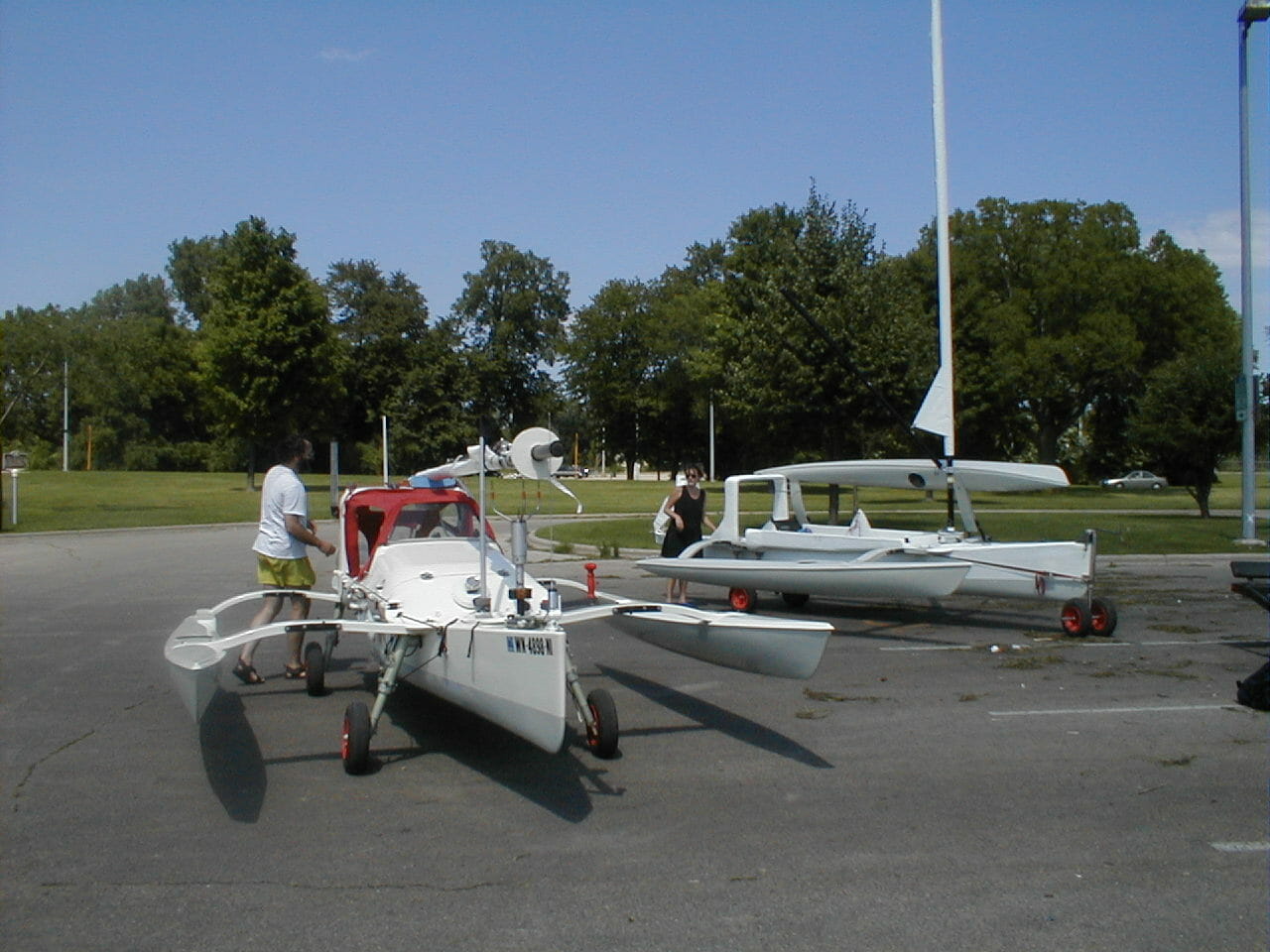
It was intense, challenging, and delightful to have the boat on water. This was Io’s fourth time afloat and Europa’s very first, and from the moment I rolled down the ramp I was simultaneously whooping it up and making lists. Basically, we just played around in the lake for a couple of hours, but with winds gusting to 20 knots and the launch ramp tucked at right angles into a rocky lee shore it taught us a LOT about these boats, including:
- First, Microship sailing is vigorous and often blissful, and I exceeded 8 knots a few times with the general sensation of screaming across the water with spray flying in all the right places (the ride is mercifully dry). Pedaling is smooth and unfortunately necessary at times to get through tacks in moderate breezes… though I suspect there may be a learning curve involved here. A few necessary refinements notwithstanding, it is clear that the Microships are generally seaworthy. This is useful information.
- My T-handle rudder control system works very well, though in the more intense gusts there was some weather helm as the freestanding mast flexed aft. I had to fight to keep from rounding up on a hard beam reach, and partial dagger retraction to nudge the CLR aft didn’t fix it. A skeg? A wee headsail? A stayed rig? None are very appealing. Tasha erred a bit with the dimensions on her temporary wooden T-handles (short arms above the pivot) and only had 2 lines to the rudder for testing… she and Tim had to work even harder to maintain helm control when the winds got feisty!
- The furler drum is rather awful. I need to add a double drum with a line looping through the cockpit from source to destination spools. I chewed up my hands trying to furl before slamming ungracefully into the bricks, pedaling upwind while barely managing to put the flogging sail away with only the bitter end of the line available. (This was fixed immediately after returning to the lab.)
- The SpinFin drive unit worked beautifully, and I only had to clear biology once.
- The gear hatches need hinges and latches; straps ‘n buckles are a nuisance. Tasha hinged her covers and made them flush with the deck… they’re easy to use but need gaskets.
- The front seat hangers are awful. Under anything more dynamic than gentle lab conditions, they would flex and drop the seat into the bilge, not to mention tearing up paint and interfering with rudder handles on every retraction. On the water, I ended up lashing them to the steering pivot cages so I’d have a stable place to sit. (This was the first thing I fixed after returning home: the seat uses Bob’s elegant vernier scheme and pivoting retraction mechanism, and the front hangs via Wichard hooks from eye straps bolted to the steering cages.)
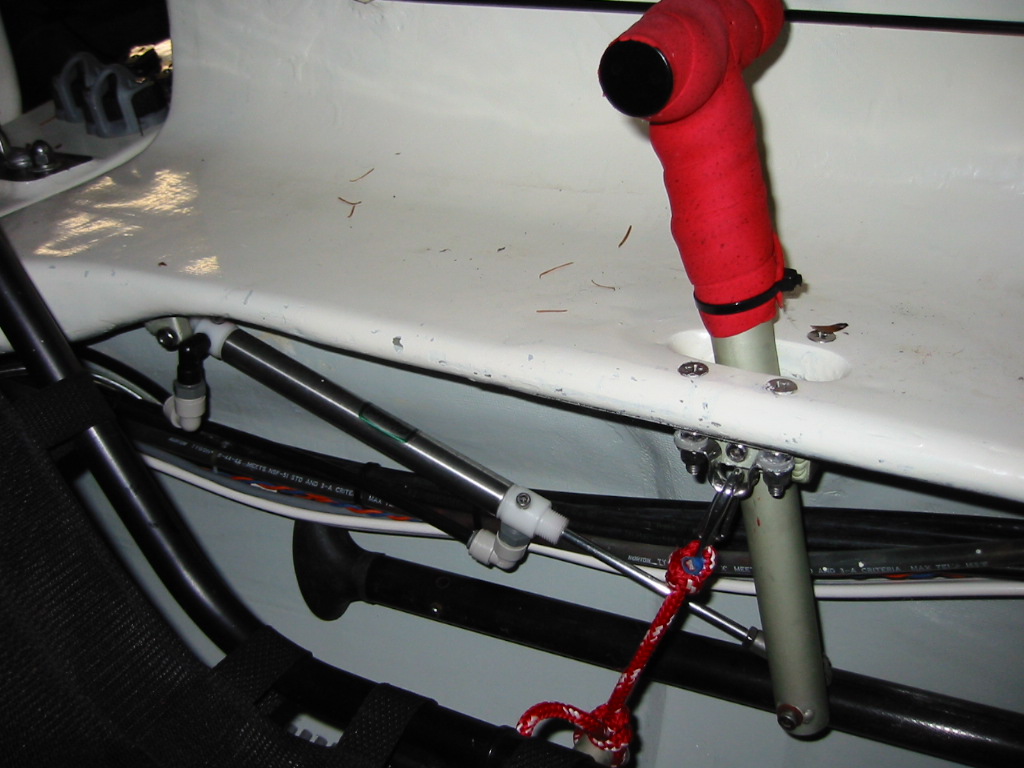
I was also reminded while scraping against the dock after making a precise approach that installation of the Gunnel Guard on both amas is a high priority. Reverting to land-mode took about 30 minutes, though we were distracted by two persistent drunks who kept wanting to shake my hand, get close to Natasha, and establish some kind of kinship (“Whoooaaa, this is like a jet fighter, man! I used to fly F-4’s in ‘Nam, and they had wheels just like this… so did you patent this thing? You should, man, an’ I could help you out ’cause like I been there, dude… let me shake your hand… tell ya what, man, this rig is a trip. Your wife, hey, she don’ wanna talk to me, guess she don’t like me much, but whooaaa, dude, she lookin’ good, no doubt about THAT…”).
We escaped a bit hastily and dove headlong into rush-hour traffic, going the wrong way on a four-lane since the sidewalk was impassable, Tim ahead of us encouraging head-on traffic to merge left. Good thing Madison is generally a friendly town, but still… the return to quiet neighborhood streets was welcome, even with one brutal hill and a castering-induced landing gear mishap resulting in steering cable slippage…
And so, we have a few more items on the TO-DO list before the next launch, but that’s what we do here at Nomadic Research Labs: spend months tackling piles of fabrication projects way out of proportion to the size of the boats, then go sailing for a couple of hours every six months. Seriously, though, I’ve reached a major checkpoint in Microship development… the test daysail series is over!
7,000 Miles in the Mothership
Phew. This was a LOT of work. It began with the arrival of the new 44-foot Wells Cargo… which started imparting harsh driving lessons the moment I hitched ‘er up at Signal Trailer Sales in Everett and tentatively pulled out of the parking lot. Yikes. This thing is HUGE… and gosh, I really have to take corners WIDE, don’t I? Whoops… sorry, ma’am… didn’t mean to terrify ya…
We only had 5 days between the level-1 learning curve and hitting the road on a huge loop around the US, and it was intense. There was one moment of relief: a disagreement forming in the vapors, poised to coalesce into a Major Argument, concerned the Mothership’s cat door. This was a high priority for Natasha, who wants our child-surrogate to always have the highest quality experience possible; it was a low priority for me, who was not keen on taking a Sawzall to my new trailer with so many other projects on the TO-DO list. But when the machine arrived, we were both delighted to see a shore-power access door, complete with lock, precisely the right size to satisfy feline needs for nocturnal prowlage. (Phew) This became known forever as the “relationship-saving cat door.”
But there remained enough projects to keep us occupied before launch, even without that one. Here I want to thank my friends Ned Konz, Phil Rink, and the late Bill Harp for working heroically to install and cable the Qualcomm Globalstar phone car kit, Icom 706 MkIIG ham rig, automatic antenna tuner, CB radio, six antennas, power distribution panel, and 2.4 GHz 2-channel wireless video link between trailer and truck. The team worked tirelessly for two days, amazingly getting it all done on the eve of departure, and the suite of communication tools proved immensely valuable on the road (Globalstar is pure magic, the Icom the best HF rig I’ve ever used, and the CB as boring as always).
Meanwhile, we were preparing the technomadic road show for public appearances, not to mention packing for 7 weeks on the road. The most frightening moment had to be the first-ever loading of BEHEMOTH and both Microships into the trailer… the whole spec, from the choice of a 44-foot unit to the placement of all 11 tie-down fixtures, had been derived on paper after careful measurement of the equipment and then faxed to the Wells Cargo plant in Utah. This was the moment of truth…
The bike was old hat; I rolled it in, installed wood tire guides with drywall screws, and strapped ‘er down. Europa was next, rolling with enviable ease across the gravel from the lab and up the ramp to nose against the gooseneck next to BEHEMOTH. So far so good. Meanwhile, as this was the night before launch, a party environment had mysteriously materialized, and by the time I gingerly trekked across the lot and up the ramp with my freshly painted Microship, gleaming in the fluorescents, a small wine-lubed group was clustered around the back of the trailer.
Just as Io reached her target spot, with about 2 inches of clearance, island artist Karla Matzke called out, “OK, just a little more — you’re hanging out about 2 feet!” Like life flashing before my eyes, I suddenly reconstructed all my careful measurements and calculations, staring in numb shock at the densely packed trailer… until a ripple of laughter revealed that she was messin’ with me.
And so, the next day we hit the road in the 56-foot rig, powered by my trusty old diesel pickup painted to match the smoke-gray trailer by the “fast food of paint” folks (they even sprayed the dirt caked in the corners of the bed and a few rubber gaskets, but hey, what should I expect for $350 — a pressure wash and careful masking?). The next 7 weeks was a mind-numbing blur of Interstate highways, spiced with magical moments but permeated by the fundamentally exhausting process of hauling equipment around for a speaking tour… something I’ve been doing every year for over a decade now (not that I’m complaining, mind you, but it’s not easy being a trucker).
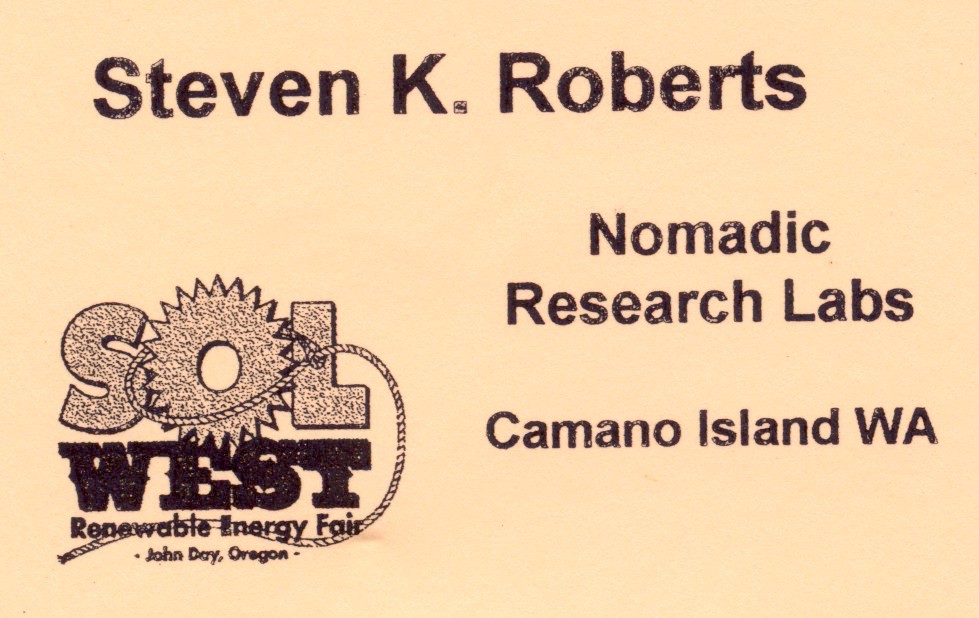
I did a dozen talks, ranging from casual parking-lot chats to full-scale keynotes, from laid-back public events to on-site corporate gigs. But it was different this time: my little boatlet, for so long represented only by hand-waving “what’s next” speculation during BEHEMOTH-centric speeches, found herself the focus of presentations at the SolWest Energy Expo, Tellabs, Life Fitness, Clippard, the Usability Professionals Association conference, the Huntsville Hamfest, Qualcomm, DraCo, Palm, The Computer Museum History Center, Classroom Connect, and Hewlett-Packard. But that alone doesn’t tell the story, which, like any jaunt across America, is less a list of gigs than a melange of strange moments…
Heat was a prevailing theme… we missed a perfect summer on Camano Island while flinging ourselves headlong into a furnace where temperatures over 100 were common and relief almost nonexistent. We almost lost everything in an Idaho town curiously named Bliss — at a tiny truck stop, parked next to a tanker, Tasha went back to add ice to the cooler and returned a moment later reporting that the trailer smelt strongly of propane and the tank was hissing. The ambient temperature was 105 and the overpressure valve was outgassing… I became highly animated despite the lack of coffee, sprinted down the long deathtrap between my rolling bomb and the one next to me, flung open the rear door to maximize airflow (wondering all the while if the process would create a static spark), then threw ice water on the tank which politely stopped hissing. Um, DUHHHH… from that moment on we carried the propane in the bed of the truck where it belongs. I could have lost Natasha, Java, Microships, Mothership, BEHEMOTH, and more. We continued across high desert, soberly exchanging dark fantasies of my reconstructive surgery in Idaho and hobbling back to my empty lab, empty house, empty life…
Other thermal issues were less potentially catastrophic, but they did wear us down. Kamping On Asphalt in Tennessee… so hot at 3 AM that we gave up and went to sleep on the grass, spiders and mosquitoes notwithstanding. The cat moping about and hiding in dark places, the miasma of sweat a constant companion, lying in the creek in John Day during the solar fair, the general misery of Alabama in August… and the tangible relief of crisp Colorado air as we returned west, becoming chilled on a mountain hike and loving it.
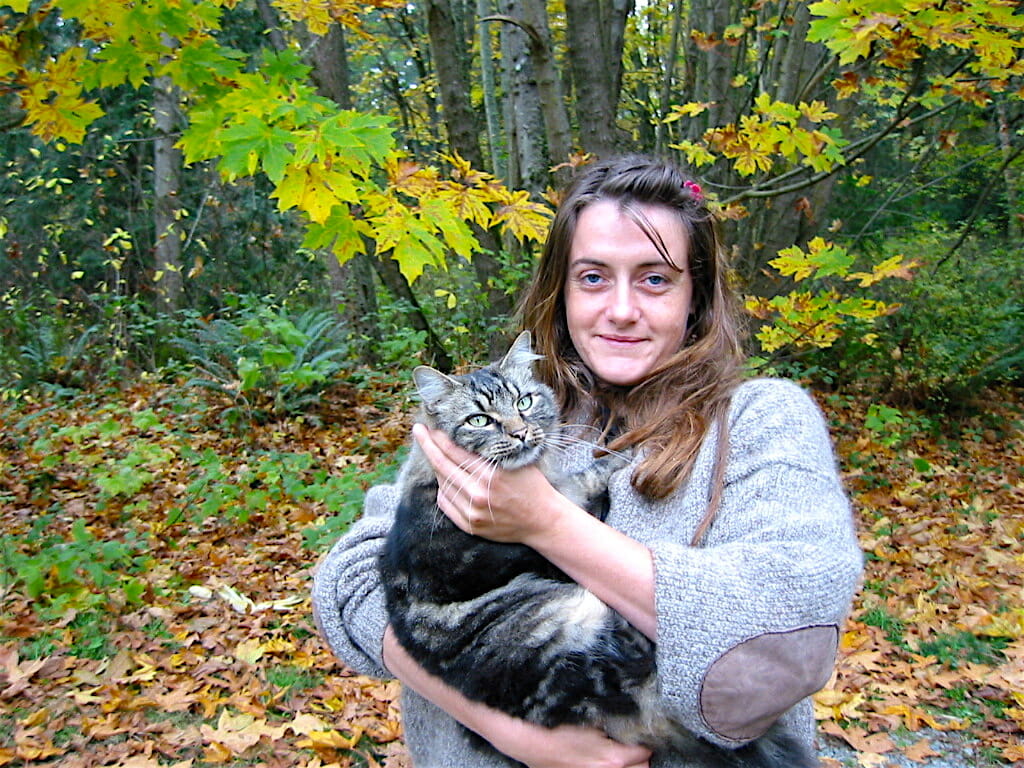
Java, who now has 25,000 miles on her, was good company most of the way — and, however cats store memories, can now dream about sneaking into fancy hotels, partying with the grownups in a big field, skulking through campgrounds and neighborhoods across the land, playing Great Furry Huntress on Safari, and giving us a big scare in Paxico, Kansas. She disappeared that hot morning, prompting us to hang around in the blazing sun for hours, wandering back and forth along the wild riverbank calling her name with declining hopes and sad images of our kitty clinging wide-eyed to the undercarriage of a Winnebago enroute to Michigan. Even the local sheriff got involved, stopping by to check on things (it was a slow crime day in Paxico) and tromping fully armed through the fields, gruffly calling “Java!” into the bushes.
We disconnected the truck and drove 30 miles for coffee and a general store… and of course on our return there she was, bored, snoozing under the trailer.
I’m tinkering with a tiny direction-finding beacon transmitter based on a crystal oscillator chip with dipole cut to a suitable odd harmonic, a technique used heavily by wizard-level hams Bill Brown WB8ELK and Pete Sias N0OY to track homemade high-altitude balloons. This will go on Java’s backpack along with a receiver that can be remotely commanded to flash LEDs and beep, as well as a Supercircuits miniature B&W camera with built-in 432 MHz transmitter. These hams were just two of the fascinating characters we visited on this trip: Pete in Kansas has a world-class microwave installation and enjoys moonbounce; Bill in Alabama is going for the CATS prize in high-altitude ballooning later this month.
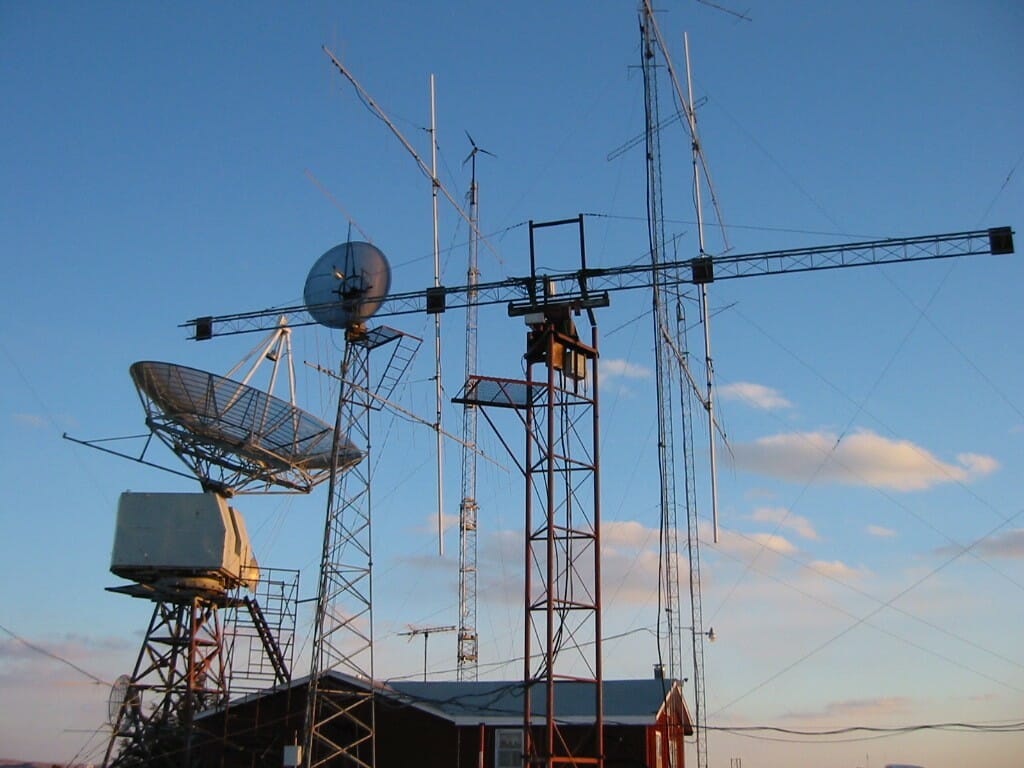
Speaking of people with good ideas, I should mention that the Microship-hauling technique took a while to get refined… by the time we reached Minneapolis, we were on revision 3 of the tie-downs and seeing tire-scrubbing, accelerated wear, and elastomeric suspension blobs taking a set from ratchet-strap tension (the boat sits an inch lower than she was, mildly annoying as the rudder and SpinFin can’t be fully deployed on land). Joe Tyner drove us around and helped experiment with inflatable jacks and better strapping; Tim Nolan built an 8-foot padded platform and helped rig a scheme with four bottle jacks, two big log rounds found at a wild Montana campsite, nylon slings from McMaster-Carr, and robust strappage from a truck stop. The boat is jacked up, taking the load off her dainty landing gear, then pulled down hard onto her broadly supported hull. (Tasha’s just sits calmly on her wheels, but we won’t discuss that, OK?)
The trip was diverse… cavorting with the energetic and passionate solar crowd in John Day (including the fine folks who put out Home Power magazine). I gave an urgent fiberglass lesson to a litigation-magnet somewhere in the north… a water slide owner who mentioned shards of fiberglass at the seams occasionally slicing kids (his horrific contraption, stressed at every joint between loosely coupled segments, was annually cobbled back together with Bondo!). We camped in conditions ranging from outlaw street sleeping and rest-area overstays to a mind-numbing RV park where Tasha got yelled at for cutting through someone’s space, but mostly stayed at commercial campgrounds with individual quirks covering the whole spectrum from mean-spirited scrooges to sweet folks who love their visitors, some of whom have been there so long that their wheels are but useless vestigial appendages…
Speaking of cultural phenomena, the Hamfest in Huntsville was characteristic of the breed, but with a twist: it was a bimodal distribution instead of the usual simple Gaussian curve of intelligence. It’s a NASA town, you know, and whenever some old guy wandered over to our bike/boat/booksales setup, we never knew whether we’d hear a dull “is this some kind of airplane?” or a delightful reminiscence about working with Dr. Von Braun or the Spacelab design team.
I smashed a finger on stage at Life Fitness in Chicago while demonstrating rig retraction, capturing the unfortunate digit between two very hard things when dropping it back in place. The fingernail turned black instantly and I grew faint, continuing my speech for the next few minutes on my knees (it was a good time to discuss landing gear and pedal drive anyway). A sharp-eyed and heroic audience member slipped away and returned with a Zip-Loc full of ice, which saw me through the ordeal…
$37.00Read more
Of course, this was a business trip at its core, and in addition to the gigs we worked to sell the new BEHEMOTH to Microship book… moving about 250 copies or so. Cash went in one pocket and out the other… for almost 700 gallons of diesel fuel ranging from $1.09 (Alabama) to $2.39 (California mountains). But the prize for the biggest rip-off goes not to opportunistic gas stations without local competition but to the Hampton Inn O’Hare in Chicago, which charges direct-dial long-distance at daytime operator-assisted rates plus 40% surcharge and tax: lazily skipping reconfiguration to the 800 number cost me $27 for 17 evening minutes online to our ISP in Washington!
The trip was long, and this story is becoming so. My apologies to all the other interesting people and companies who became part of the adventure… I just don’t have the space to tell the tales of clambering in the Rockies and Santa Cruz mountains, delighting in Boulder’s marimba culture including an all-kids band that’ll knock your socks off, the endlessly stimulating folks of Draco and Qualcomm, favorite old friends in the Bay Area who descended en masse on my museum presentation, Bob Ellingson (of Halted) and his collection of amazing pinball machines, spending time with Maggie, enjoying the sparkling minds of David Berkstresser and Tom Hoobyar, investigating potential educational spinoffs of our adventure, hanging with new and old pals in Eugene and Corvallis, visiting my father in Kentucky, and ohhh, so much more.
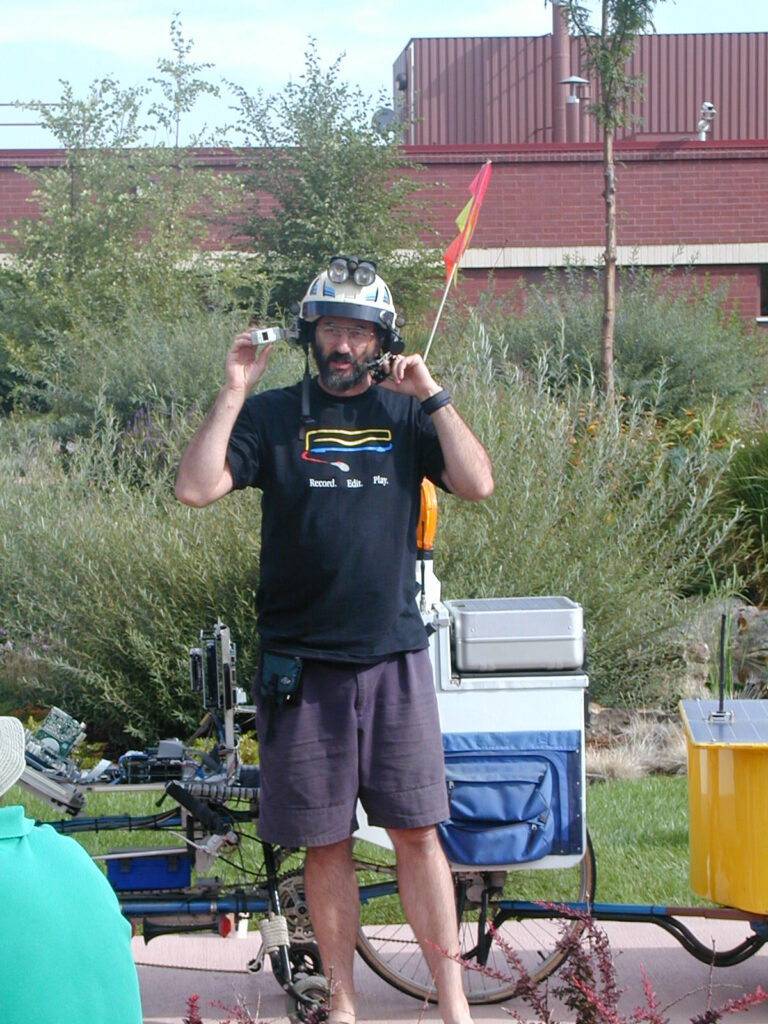

One last note on the trip. BEHEMOTH now has a new home at the Computer History Museum in Mountain View, California. It was inaugurated by my speech in the NASA auditorium, and the road-weary bike, pedaled 17,000 miles and trucked about ten times that, is now kicking back with the Mars rover, a few robots, Crays various, an Enigma machine, and an incredible collection of artifacts spanning the entire history of computers. It’s an unbelievably fascinating place, and I highly recommend a visit. It already attracts interesting people and special events… on our last night there, we had the pleasure of demoing bike and boat to Douglas Adams, John Perry Barlow, Len Kleinrock, and a number of other characters whose wealth of ideas keep conversation hopping like a drop of water on a pancake griddle…
And that’s what it’s all about.


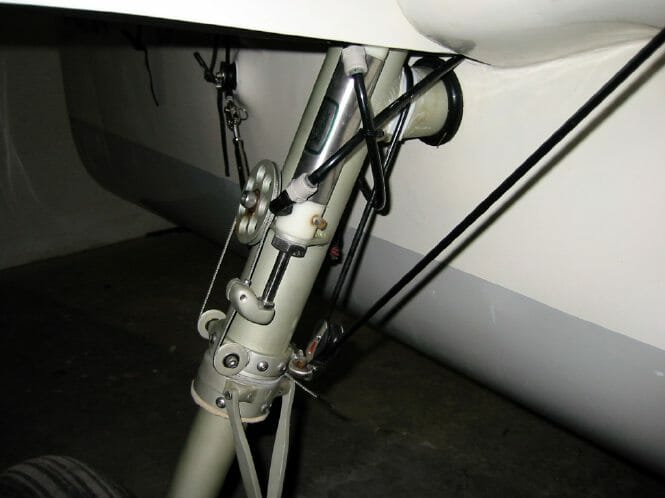
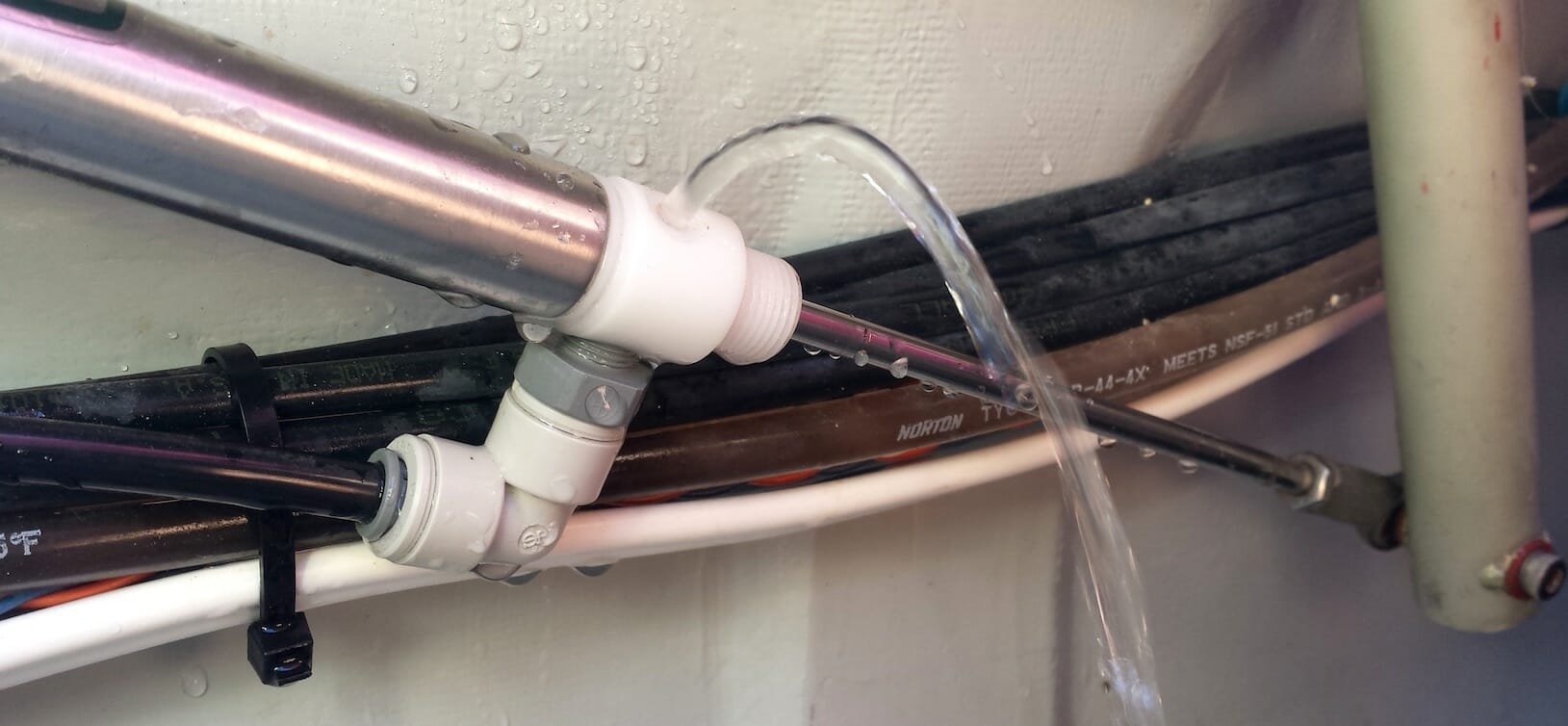
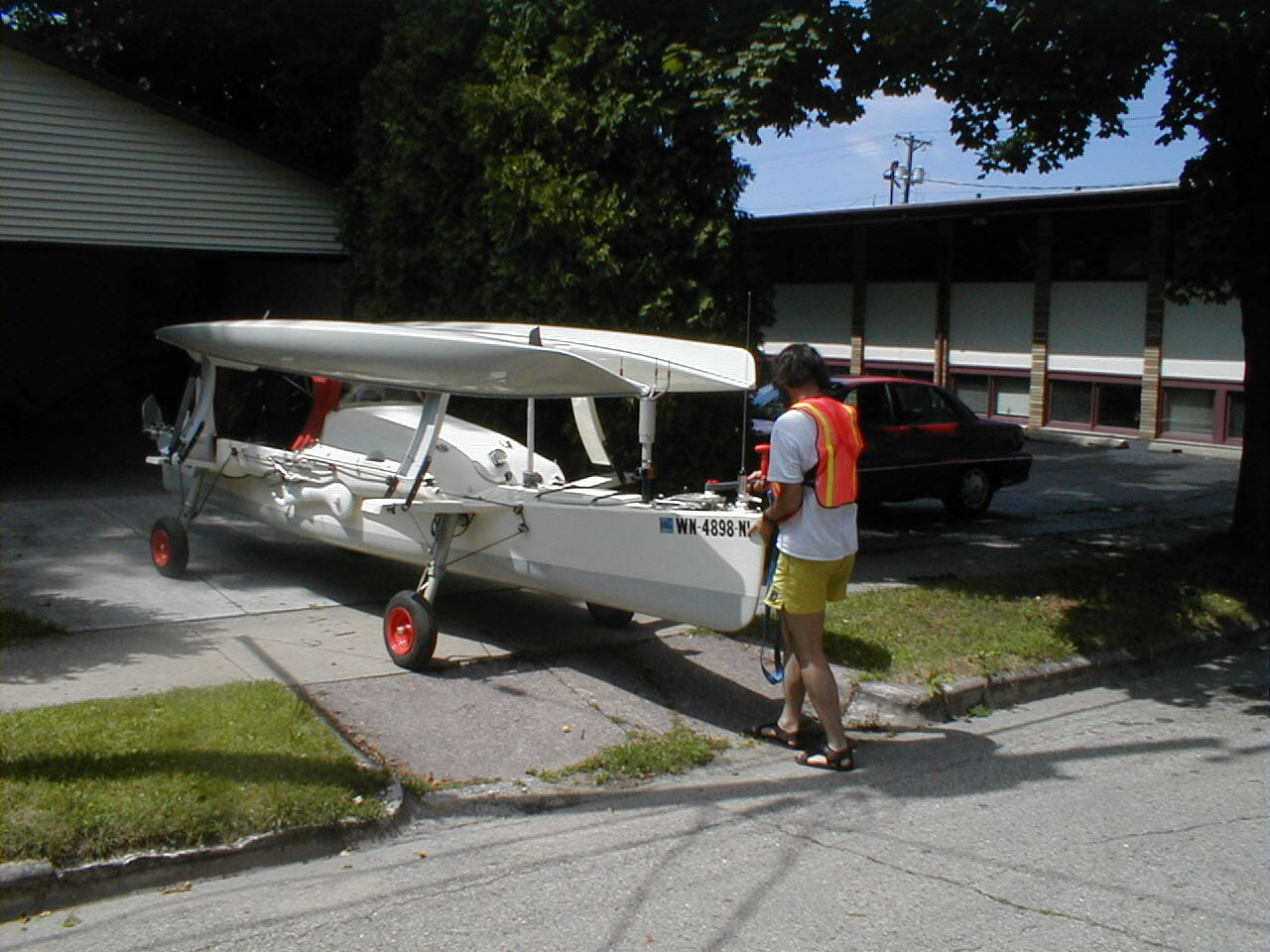
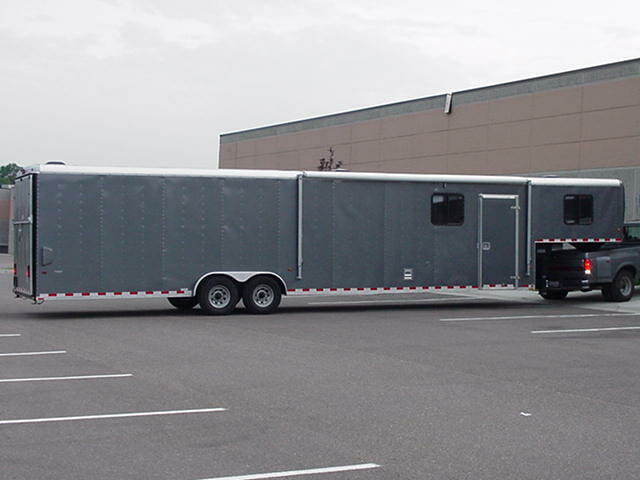

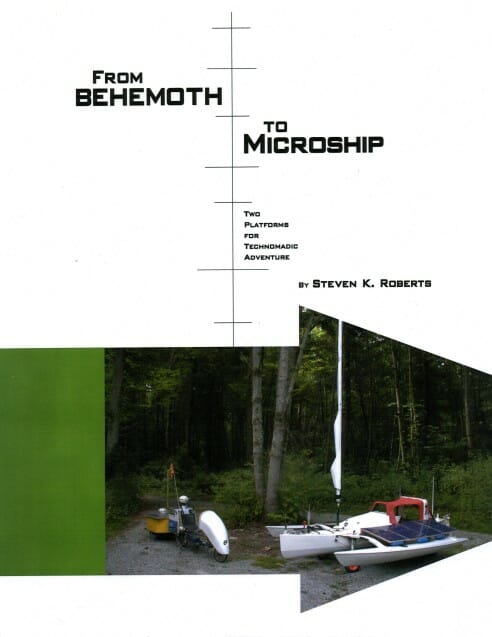
You must be logged in to post a comment.